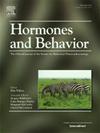Conspecifics confer survival advantage in the face of night-light polluted environment: Evidence from melatonin secretion, sleep, mood and cognitive performance in Indian house crows
IF 2.4
3区 医学
Q2 BEHAVIORAL SCIENCES
引用次数: 0
Abstract
The survival advantage of group living remains poorly understood. Here, this was investigated by using several physiological and neurobehavioral traits in Indian house crows (Corvus splendens) in the face of a temporally disrupted day-night environment. Crows were housed singly or with two other conspecifics and subjected to daily 12-h light and 12-h periods of complete (0 lx) or dimly lighted (∼6 lx) dark nights. Nocturnal melatonin and sleep levels were measured as indices of the direct and circadian effects, while mood (feeding, preening, and self-mutilation) and cognition (innovative problem-solving task) performances were considered reflecting the higher-order brain function effects. Under 6-lx dim light at night (dLAN) condition, group housing alleviated the depressive-like responses and enhanced cognitive performance but had no effect on the midnight melatonin levels and nocturnal sleep consolidation. Concurrently, there were increased nr4a2 and decreased tnfr1 gene expressions in hippocampus, increased dcx and darpp-32 gene expressions in the nidopallium caudolaterale, and th expression in midbrain. We interpret that an increased conspecific interaction improved mood and cognitive performance without affecting the melatonin secretion and sleep in communally roosting house crows. Perhaps, living with conspecifics is part of an overall evolutionary strategy to enhance the survival in a highly social species like the Indian house crow.

同种生物在面对夜间光线污染的环境时赋予生存优势:来自印度家鸦褪黑素分泌、睡眠、情绪和认知表现的证据
人们对群体生活的生存优势仍然知之甚少。在这里,通过使用印度家鸦(Corvus splendens)在面对暂时中断的昼夜环境时的几种生理和神经行为特征来研究这一点。乌鸦被单独饲养或与其他两只同种动物一起饲养,每天接受12小时的光照和12小时的完全(0 lx)或昏暗(~ 6 lx)的黑夜。夜间褪黑素和睡眠水平被测量为直接和昼夜节律影响的指标,而情绪(喂食、梳理和自残)和认知(创新解决问题的任务)表现被认为反映了高阶脑功能影响。在6-lx夜间昏暗灯光(dLAN)条件下,集体住宿减轻了抑郁样反应,提高了认知表现,但对午夜褪黑素水平和夜间睡眠巩固没有影响。同时,海马nr4a2基因表达增加,tnfr1基因表达减少,尾叶蕨dcx和darpp-32基因表达增加,中脑表达增加。我们解释说,增加的同域互动改善了情绪和认知表现,而不影响褪黑激素分泌和睡眠。也许,与同种物种一起生活是整体进化策略的一部分,以提高像印度家鸦这样高度社会性物种的生存能力。
本文章由计算机程序翻译,如有差异,请以英文原文为准。
求助全文
约1分钟内获得全文
求助全文
来源期刊

Hormones and Behavior
医学-行为科学
CiteScore
6.70
自引率
8.60%
发文量
139
审稿时长
91 days
期刊介绍:
Hormones and Behavior publishes original research articles, reviews and special issues concerning hormone-brain-behavior relationships, broadly defined. The journal''s scope ranges from laboratory and field studies concerning neuroendocrine as well as endocrine mechanisms controlling the development or adult expression of behavior to studies concerning the environmental control and evolutionary significance of hormone-behavior relationships. The journal welcomes studies conducted on species ranging from invertebrates to mammals, including humans.
 求助内容:
求助内容: 应助结果提醒方式:
应助结果提醒方式:


